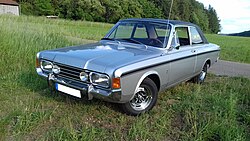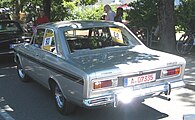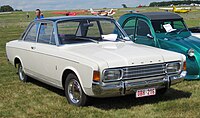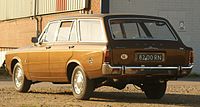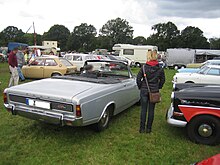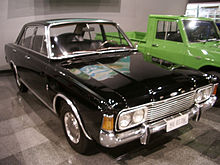Ford P7
| ford | |
|---|---|
|
Ford 20M RS
|
|
| 17M / 20M / 26M (P7) | |
| Production period: | 1967-1971 |
| Class : | upper middle class |
| Body versions : | Sedan , station wagon , coupé , convertible |
| Engines: |
Petrol engines : 1.7–2.6 liters (44–92 kW) |
| Length: | 4673-4721 mm |
| Width: | 1756 mm |
| Height: | 1464-1478 mm |
| Wheelbase : | 2705 mm |
| Empty weight : | 1050-1230 kg |
| Previous model | Taunus 17M / 20M (P5) |
| successor |
Ford Consul Ford Granada |
The Ford P7 (= project 7, d. H., The seventh new car -construction of Ford-Werke Köln since the end of World War II) was an automobile the upper middle class with V-4 or V-6 engines and rear drive as Ford 17M , 20M and 26M came on the market.
From August 1967 to December 1971, the Ford plants in Cologne-Niehl and Genk (Belgium) produced 567,482 units.
The models 20M and 26M were replaced by the Ford Granada in spring 1972 , while the successor of the Ford 17M, which was identical to the Granada, was called Ford Consul .
With the P7, the internal term "project" ended at Ford Cologne for cars.
Model history
General
In August 1967 the Ford 17M and Ford 20M (internal P7a) were presented. The two types no longer bore the brand name "Taunus", but the manufacturer name Ford .
In sources it can be read that the German Ford-Werke AG was not allowed to use "Ford" as a brand name on the vehicles until the founding of Ford of Europe in 1967. That is why they did not have any Ford logos on the vehicle until then; instead, the brand name “Taunus” was attached. In the literature there are indications that the name change was also the result of an opinion poll, the result of which was that a car was only ever named with a maximum of two type designations (for example “Ford” and “17M” or “Ford” and “Taunus” ) should be.
Ford P7a (1967-1968)
For the introduction of the new model, the models were 17M and 20M as two- and four-door sedans, three- and five-door station wagon versions tournament available and as a hardtop coupe with a shorter roof and flat standing rear window. The 17M was also available as a panel van without a rear window. In addition, the bodywork company Deutsch manufactured a convertible version in Cologne-Braunsfeld .
The RS variants on offer should appeal to the sporty buyer. The RS models were equipped with painted or chrome-plated 14-inch steel sports wheels. The chrome-colored RS radiator grille was partially set off with black stripes. In addition, two round high-beam headlights were incorporated there. The black dashboard, equipped with four round instruments, contained the fuel gauge, the speedometer, a rev counter and the engine temperature gauge. The center console, also in black, contained three additional instruments ( clock , mechanical oil pressure indicator, voltmeter). All instruments were decorated with chrome-colored rings. The RS decorative stripes on the long sides and RS emblems with a stylized starter flag on the glove compartment lid and tailgate rounded off the sporty appearance of the RS variants. "RS" is the internal Ford designation for "Rallye Sport".
Outwardly, the 20M differed from the 17M in that it had a different radiator grille, a different rear panel with different taillights and an additional air scoop on the bonnet and a sill molding.
The P7a was available with various engines. The motorization ranged from the 17M 1500s with 60 HP to the 20M RS with 108 HP, optionally also for a short period with 125 HP (June and July 1968). This Ford was also available as a German convertible. 17 vehicles were produced. 10 have been preserved. (Source: Ford M Club Norway)
The P7a 17 and 20M were also exported to Canada.
Ford P7b (1968-1971)
After only ten months of construction of the predecessor, the successor to the unloved "Kummerfalte" was presented in August 1968. The American or British-inspired body shape with a "hip curve" (also known as "Kummerfalten") did not meet the public's taste, which is why the shape was smoothed after barely a year. Ford returned to the "line of reason", a slogan that had already been used for the previous P3 model.
This new model, which has been freed from swinging the hips, is referred to as the P7 / II model series or P7b according to the factory documents. With these in-house models called “Facelift P7”, the aim was to forget the failure of the previous year. For this purpose, tried and tested methods were used: the lateral hip curve was straightened, the dummy air scoop on the bonnet of the 20M was omitted and the bumpers were pulled up to the side and integrated into the body. The front turn signals and taillights were also harmoniously connected to the ends of the bumpers, as they did on the P5. The rear window of the coupés and limousines are relatively flat, so that the limousines also look a bit like a coupé.
On the new, shorter steering column there was now a safety steering wheel with a collapsible impact pot. Also new was the heated rear window and a foot-operated tip wiper switch for the windshield wiper combined with the windshield washer (both were standard on all models except the 17M basic model). The former 20M TS has now been replaced by the new luxury version 20M XL. Wide chrome strips on the wheel arch, metallic paint, real wood veneer over the entire width of the dashboard, on the instrument panel, on the center console and on all the top edges of the door and a wood-grained steering wheel with brushed spoke ends made of stainless steel were also part of the standard scope of delivery, as were contoured seat recesses in the rear bench. From October 1969, all V6 engines were given a new, three-stage cooling system with a water pump integrated in the spur gear cover.
The 1.7 L HC V4 engine ( " H igh C ompression") of 17M now made thanks carburetor 75 hp (55 kW) instead of 70 hp (51 kW). The 1.8-liter HC V6 with 82 PS (60 kW), also reserved for the 17M, was new to the range. In addition, the 17M was still delivered with the 2.0-liter or 2.3-liter Cologne V6 engines. On special request, the 3-liter Essex V6 was installed, an engine that is popular in South Africa, for example. The rigid rear axle, which continued to be suspended from longitudinal leaf springs , was now also guided on longitudinal links (the so-called "journalist rods "). At the front it stayed with MacPherson struts and wishbones , but their springs and the stabilizer were retuned.
The 3.0 liter Ford engines are known as Essex engines, which has to do with the fact that these engines were manufactured in Ford's UK factories in Dagenham and Brentwood , both in Essex .
At the beginning of the 1970s, the turbo era began for various Ford models, including the P7b. For example, the Ford dealer Schwabengarage AG in Baden-Württemberg equipped the 20M RS with an exhaust gas turbocharger from the Swiss engineer and former racing driver Michael May . Instead of the standard 108 hp, the engine now developed 188 hp. This enabled the RS to reach a top speed of 190 km / h. The acceleration from 0 to 100 km / h took 7.9 seconds. However, in order to make the charged P7b safer, the engine and the chassis were modified (Koni shock absorbers, larger brakes, reinforced struts, etc.). A standard 20M RS 2.3 cost DM 10,267.50 at the time. The Turbo May conversion kit cost DM 3,252.30 additional. However, there were other special accessories available from May for his Ford.
There were three equipment variants for the P7b: Standard (17M, 20M), XL (20M XL, 26M) and RS (17M RS, 20M RS). The RS models had black foiling and two additional lights in the grill. The 17M RS received silver-painted steel sports bikes with black-painted inlays, the 20M RS were chrome-plated, also with black-painted inlays. The chrome-plated side and wheel arch strips, standard on the XL models, were available as accessories for the RS. The RS and XL models differed not only on the outside, but also in the interior. The XL models were dignified thanks to the extensive use of wooden panels in the interior, while the RS models with additional round instruments in the center console and dashboard were more sporty. (The difference in the interior between the 17M RS and 20M RS was, among other things, that the 20M RS, unlike the 17M RS, was given a subtle wooden paneling.) Even the luxurious 26M did not have a rev counter, which was standard on the RS models! At the beginning of the 1970s, the RS models of the P7b were not in great demand, but now they are sought-after collector's vehicles and (in good condition) accordingly rare.
In South Africa the right-hand drive 20M was offered with a V6 3.0 Essex engine. The 17M, which is also available, could be ordered with a V4-2.0 Essex engine, which was also manufactured there, and with a V6-2.5 Essex engine. The South African Ford models differed somewhat from the German ones. So the 20M RS appeared very sporty. In addition to the extensive black foiling, a large air scoop was mounted on the hood. In the last year of construction of the P7b, the 20M got the front design of the German 26M with double headlights, and the 17M got the front of the 20M. In South Africa, the P7b was produced a year longer than in Germany (until the end of 1972). Rumors say that P7b with a V8 “Small Block” also rolled off the production line in small series. This V8 Windsor "Small Block" engine from the Ford Mustang had an output of 176 kW (240 hp) and was also used in the Ford Capri and Granada Perana . With regard to the P7b, however, evidence is still lacking. It may also be that there were only a few prototypes that were manufactured for test purposes. However, it is documented that some owners of P7b in South Africa retrofitted their vehicles with this type of engine. The aforementioned Ford Capri and Granada Perana models with V8 from Basil Green Motors were only available as right-hand drive and are now very sought-after and rare.
In 1970, the P7 was sold in Uruguay as a pick-up version under the name Serrana 70 . The Serrana was not a car that was made in the Ford factory, but was assembled with parts of the P7a by local dealers in Uruguay. The engine was a V4. Ford Taunus and P5 were also built there as pick-ups.
In 1969 Ford was successful with a P7b in one of the toughest rallies in the world. A modified 20M RS, with drivers Robin C. Hillyar and John 'Jock' Aird, took first place in the East African Safari Rally . But specially built 20Ms were also used in touring car races on the African continent. In South Africa , the 20M was very popular in racing, for example Eddie Keizan , a former Formula 1 driver, also drove a 20M there in the 1970s.
Restorations in vintage car dealerships of P7 models that have rust damage and other serious defects are very labor-intensive, take a lot of time and are therefore not cheap. Good, new original parts are sometimes no longer at all and when they are, expensive and difficult to find. Not infrequently it can happen that spare parts have to be manufactured or refurbished. The spare parts supply for these older Ford models is worse than that of Volkswagen, for example, where the parts supply for their classic cars is much better. Ford's central spare parts store burned down in 1977, with most of the parts for older models being lost.
26M (1969-1971)
As of November 1969, presented at the IAA new flagship of Ford was available: the 26M that the counterpart of the highly successful Opel Commodore A should be. However, Ford only built 8,000 26Ms, a fraction of the number of the Opel Commodore A (156,467).
The 26M was slightly larger than the Commodore A. The weight of both vehicles was almost identical. Both models were equipped with six-cylinder engines, but Ford and Opel pursued different approaches. The Ford was designed for comfort, while Opel, particularly the GS models, pursued a sporty line. The in-line six-cylinder engine of the Commodore A performed better than the V6 engine of the 26M. As early as 1970 you could order the Commodore GS / E with a 150 hp engine and Bosch D-Jetronic injection. That was 25 hp more than the new twin carburetor engine of the 26M could deliver.
For Germany, Ford only had the 2.6-liter engine with 125 hp for the 26M, while for the Opel Commodore A you could choose between various engines with different outputs from 95 to 150 hp and carburettor or gasoline injection. In South Africa, the more powerful 3.0-liter engine with 138 hp, the well-known “Essex” engine, was available for the Ford 20M models there ( Ford 20M 3000S ). After the model change in 1972, this engine was finally available in Germany for the Ford P7 successor models Consul and Granada.
The 26M was based on the 20M-XL luxury sedan and was equipped with the new 2.6-liter HC-V6 with 125 PS (92 kW). This engine had a double Solex carburetor . The engine's crankshaft worked with a vibration damper. As standard, the car was equipped with the automatic transmission, the new power steering, the enlarged disc brakes, the continuous double exhaust system with two chrome-plated tailpipes of the 20M RS, a new cardan shaft with constant velocity sliding joint and Michelin belted steel tires. It could be recognized from the outside by the halogen double headlights, the standard leatherette- covered roof , the full wheel covers with five-star ornament and the standard deep green tinted heat protection glazing. Inside there was, in addition to the equipment of the 20M XL, a standard Blaupunkt Frankfurt radio with fader and second loudspeaker in the rear, as well as an extensive sound absorption package. The series was also a steel sliding roof that could be opened by hand crank. An electric steel sunroof was also available for an extra charge.
The 26M was equipped with an automatic transmission as standard, but could also be ordered with a manual transmission. This vehicle was available as a four-door sedan and as a two-door coupé. The coachbuilder Karl Deutsch also offered the car as a convertible. As mentioned above, 8,000 units of the P7b 26M were made, which is very few in view of the nearly 570,000 P7b produced. Commonly known as 26M, the official vehicle designation is named in the vehicle documents: 26M XL .
Double headlights and green-tinted heat protection glazing were reserved exclusively for the 26M; they were also not available on request for the other models. From 1969, however, the power steering could be supplied for all 17Ms (except with a V4 engine) and for all 20Ms on request. The 2.6-liter engine was also available as an option for the 20M models (for the 20M RS only from September 1970). The top speed was 180 km / h with gearshift and 175 km / h with automatic. The acceleration from 0 to 100 km / h took 10.4 seconds. The consumption was given as 10.8 liters of super. The 26M cost DM 13,745 in 1970, which is roughly on par with a 20M RS with May turbo.
Even then, the 26M was hardly to be found on the streets. In the meantime, only around 35 units (as of the registration office, early 2017) in different states and versions (sedan, coupé, German convertible) are registered in Germany. There are still a few 26M in neighboring countries.
The rarest vehicle in the P7b series, however, is the 26M convertible with its fully retractable top, which was handcrafted by the bodybuilder Karl Deutsch in small (st) series. For this purpose, Deutsch received the body of the two-door P7b coupé from the Ford works for the body. For Ford itself, the route through the coachbuilder Deutsch was cheaper than setting up a separate production line in the factory for a few vehicles. Only a few of these 26M German convertibles are currently likely to still exist in Germany and neighboring countries, also due to the fact that this type of vehicle is even more susceptible to rust than the closed variants of the P7b.
variants
Model variants
- 17M
- 17M RS
- 20M
- 20M TS (1967-1968)
- 20M XL (from 1968)
- 20M RS
- 20M TX (special model, only in Southern Europe and South Africa)
- 26M XL
Available engine variants in Germany for the P7 (17M, 20M, 26M)
The engines and chassis technology hadn't changed compared to their predecessor: V-engines , rear-wheel drive , front independent suspension with MacPherson struts and wishbones, and a rigid axle on leaf springs at the rear . Ford held on to this technically outdated rear axle design for a long time - the last German large-scale production car with a rigid axle and leaf springs was the Ford Capri II '78 , which was built until 1986 . Only the successor Ford Consul and Granada introduced in spring 1972 got a modern semi-trailing arm rear axle . The P7 had an on-board power supply with 12 volts and a dual-circuit brake system .
- 1500 cm 3 60 HP V4 LC
- 1700 cm 3 65 HP V4 LC
- 1700 cm 3 70 PS V4 HC
- 1700 cm 3 75 PS V4 HC
- 1800 cm 3 82 hp V6 HC
- 2000 cm 3 85 hp V6 LC
- 2000 cm 3 90 hp V6 HC
- 2300 cm 3 108 HP V6 HC
- 2300 cm 3 125 PS V6 SHC
- 2600 cm 3 125 PS V6 HC
(LC = Low Compression / low compression and regular gasoline, HC = High Compression / high compression and premium gasoline)
License replicas
Hyundai from South Korea marketed the P7b model series for Ford in Asia and converted them to comply with local regulations.
Web links
- Ford M Model Information - 1952–1972
- Information about the May Turbo installation kit and May special accessories - Ford P7b 20M and Capri
- TV documentary "East African Safari Rally" - 1969
- Article from a car magazine about the rally successes of the Ford P7b 20M RS - 2003
- TV Advert USA / Canada - Ford P7a 17 and 20M - 1968
- Ford advertisement, South Africa - Ford P7b 17M RS - 1969
- TV Advert England - Ford P7b 17M - 1970
- Advertisement Uruguay - Ford Serrana 70 - 1970
- Ford advertisement, South Africa - Ford P7b 20M 3.0 - 1970
- Ford advertisement, South Africa - Ford P7b 20M Station Wagon - 1971
- Cover of car magazine Car , South Africa - Ford P7b 20M RS 3.0 - 1971
- Ford advert , South Africa - Ford P7b 20M - 1971
- Ford advert , South Africa - Ford P7b 20M - 1972
- Ford promotional photo, South Africa - Ford P7b 20M - 1972
literature
- Werner Oswald : German Cars 1945–1975 . Motorbuch-Verlag, Stuttgart 1976; here: pp. 172–176.
- Alexander Weinen: Ford M models 12m - 26m: 1952–1972 - development, history, technology, pictures . Heel, Königswinter 2002, ISBN 3-89365-439-9
Individual evidence
- ↑ https://org3-www.hyundai.com/worldwide/en/about-hyundai/corporate/information/vehicle-history/1960/ford-20m
Remarks
- ↑ The Granada was only available with V6 engines, whereas the Consul, which was equipped with V4 engines as standard, could optionally also be ordered with V6 engines. However, the slightly less luxuriously equipped Consul was mainly ordered with the cheaper V4 engines. The Consul GT and the Granada Ghia, both equipped with the V6 3.0 Essex engine, are the most popular versions of these two model series in collectors' circles today.
